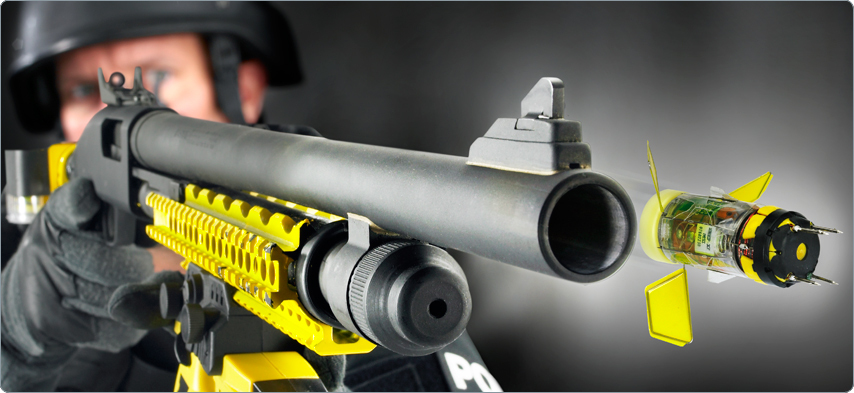Related articles:
– Wireless Tasers extend the long arm of the law
– Sold as non-lethal, Tasers killed 400 in US, Canada since 2001
– Cops raise Taser safety claims; Metro officers hurt during training sue company(!)
Taser applications:
– Police State: Cops pepperspray, taser mentally challenged, deaf man, while using the toilet
– Police State: Cops Taser Child 19 Times Leaving Him in a Coma
– Police State: Cop Tasers Mom In Front of Her Children
– Unedited Dash Cam Footage of Grandmother Being Tased
– Taser use to obtain DNA not unconstitutional: NIAGARA COURTS RULING
– Prison officer zaps children with 50,000-volt stun gun ‘to show them what a day at work is like’
– Top cop fired for allegedly using Taser on wife
– Ex-NFL Player Tasered For Pointing At Cop

THE manufacturer of the Taser stun gun is sparking new controversy with the commercial launch of a long-range version that can be fired from a 12-bore shotgun.
Government-funded tests on initial versions of the new Extended Range Electronic Projectile (XREP) have revealed possible health risks to people on the receiving end, New Scientist has learned. The manufacturer, Taser International of Scottsdale, Arizona, says the issue has been addressed in redesigned devices, but these have yet to be independently tested.
Unlike the current Taser X26, which fires darts attached to short wires, the XREP is wire-free. Its projectile, the size of a shotgun cartridge, is designed to pierce the target’s skin and contains battery-powered circuits that deliver a debilitating shock. It has a range of 20 metres or more, compared with 5 metres for previous Tasers.
A team led by Cynthia Bir, a trauma injury specialist at Wayne State University in Detroit, Michigan, found that some of the 275 XREP cartridges that Taser supplied for testing last year were capable of delivering an electric shock for more than 5 minutes, rather than the 20 seconds of shocking current they are supposed to generate. Previous Taser stun guns shock for only 5 seconds per discharge, though that can be repeated.
Bir’s team reported their findings at a conference on non-lethal weapons in Ettlingen, Germany, in May. Steve Wright of Leeds Metropolitan University in the UK, who has studied electric shock weapons, says Bir’s report that the device can carry on shocking for 5 minutes is worrying. The effects of prolonged shocking are not known, he says, but the finding raises concerns about the potential damage to a victim’s mental health.
Bir also found problems with the weapon’s accuracy. In test firings, it proved difficult to aim, as the aerodynamics of the projectile caused it to fall below the aiming point at a range of 20 metres. “Any lack of accuracy means a greater risk of hitting an unintended part of the body and therefore greater risk of injury,” says security researcher Neil Davison, author of a recent book on non-lethal weapons.
Steve Tuttle, a vice-president of Taser International, says the XREP munitions supplied for Bir’s tests were early pre-production versions. He says a redesign of the projectile has greatly improved its aerodynamic accuracy, and the fault in the munition’s “firmware” – its built-in software – that led to it being capable of providing an extended shock has also been corrected.
The two production versions of the XREP device include features said to improve aiming accuracy. One version, for use with rifled shotguns, has a plastic cap that engages with the rifling and gives the projectile a stabilising spin. The version for smooth-bore shotguns sprouts stabilising fins when it leaves the barrel.
Tuttle says, however, that Taser did ship some pre-production batches to US police departments.
Bir and her team have not had a chance to test the newly modified production rounds that Taser says are more accurate and reliable. Some of them have, however, already been purchased, delivered and used by unnamed “agencies” in the US, Tuttle says. Tests funded by Taser showed the rounds to be safe in terms of their impact effects on cadavers, he says. “There was no internal damage in the vicinity of the XREP impact.” There is no requirement under US law for them to undergo independent pre-sales testing.
Bir’s tests are being funded by the UK Home Office, the US National Institute of Justice and the Canadian Police Research Centre. All want to know whether the weapon can do what Taser International claims: allow police officers to incapacitate people at greater distance.
For this, the ability to take precise aim is seen as crucial. “In public disorder situations accuracy at range will be particularly important, perhaps to target individuals within a tightly packed group,” a review of “less-lethal” technologies by the Home Office states. Such weapons will help contain crowds or prevent them re-forming, the review says.
Shooting cadavers is one thing. But what happens when the weapons are fired at pregnant women, people with health problems or the very young, Wright asks.
What happens when the weapons are fired at people with health problems or the young?
“The Home Office will probably say they are merely evaluating a wide range of possible long-range devices and that it doesn’t mean they will necessarily deploy them,” Wright comments. “But that is what they initially said about the original Taser.”
August 26, 2009
by Paul Marks
Source: The New Scientist
“Shooting cadavers is one thing. But what happens when the weapons are fired at pregnant women, people with health problems or the very young, Wright asks.”
WHO THE HELL IS SHOOTING CHILDREN AND PREGNANT WOMEN WITH A STUN GUN!